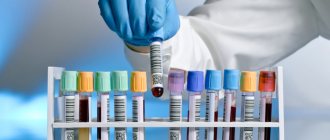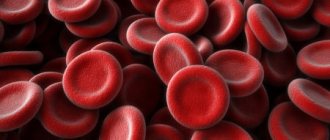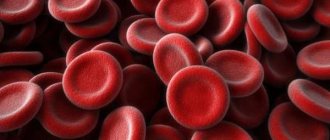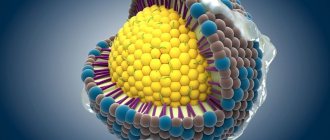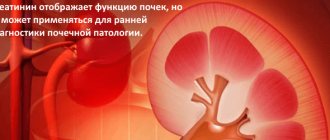The norms of ALT and AST in the blood of women have clear boundaries.
These indicators are determined during a biochemical blood test to diagnose various diseases and mean different levels of enzymes in the blood plasma.
Find the answer Are you having a problem? Enter “Symptom” or “Name of the disease” into the form, press Enter and you will find out all the treatment for this problem or disease.
The site provides reference information. Adequate diagnosis and treatment of the disease is possible under the supervision of a conscientious doctor. Any medications have contraindications. Consultation with a specialist is required, as well as detailed study of the instructions! Here you can make an appointment with a doctor.
Normal ALT and AST in women
In women, indicators are considered good if the ALT concentration does not exceed 31 U/l.
The normal level of ALT in women's blood is a value ranging from 20 to 40 units. The normal AST level in women’s blood is 34-35 IU. The presence of deviations in indicators to a smaller or larger direction is evidence that changes are occurring in the body. If the indicators are increased by 2-5 times, then the increase is considered moderate. An increase of 6-10 times indicates an average increase in results.
If the indicators are 10 times or more above the norm, then this is a high increase. To find out the causes and correct the results, an individual consultation with a specialist is required with the appointment of additional examinations.
Biochemical blood test for AST
In most cases, the doctor prescribes blood tests for ALT and AST at the same time.
Aspartaminotransferase (AST) is an enzyme that is involved in the metabolism of amino acids. Its greatest amount is found in the cells of the liver, cardiac myocardium, nerve tissue, and muscles. This enzyme is also found in the cells of the pancreas, kidneys, and lungs. In case of damage and pathologies of the above organs, AST is released into the bloodstream, and therefore its content in the blood test increases.
Indications for analysis
- diagnosing liver pathologies;
- diagnosis of myocardial infarction and some other diseases of the heart muscle;
- diagnosing pathologies of skeletal muscles.
Norm
The norm of AST in the blood of children under 12 months should be no higher than 60 U/L, up to nine years – no higher than 55 U/L, in adult men – less than 41 U/L, in adult women – less than 31 U/L.
Increased values
The level of aspartaminotransferase in the blood increases with the following diseases and conditions:
- toxic, viral, alcoholic hepatitis;
- primary and metastatic liver cancer;
- acute pancreatitis;
- cholestasis;
- severe attack of angina, myocardial infarction;
- pulmonary artery thrombosis;
- angiocardiography, cardiac surgery;
- rheumatic carditis in the acute stage;
- myopathies (chronic muscle diseases);
- skeletal muscle injuries;
- heatstroke;
- burns.
A slight increase in AST is observed with excessive muscle load.
Reduced value
A decrease in the level of this enzyme in the blood indicates a deficiency of vitamin B6 in the body and severe liver pathologies (liver rupture).
Meaning of terms: ALT, AST
These are types of enzymes from the group of transferases used in medical practice to detect the level of damage to internal organs.
Normally, a small portion of these enzymes enters the blood. In the presence of pathologies, these enzymes are determined in the blood to a lesser or greater extent than normal, which is determined by laboratory methods.
The level of ALT in a woman’s blood allows us to determine the presence and extent of liver damage. The AST level allows you to assess, in addition to the condition of the liver, the degree of damage to the heart muscle.
Biochemical blood test for ALT
Alanine aminotransferase (AlAT) is an intracellular enzyme from the group of aminotransferases that takes part in the metabolism of amino acids.
The largest amount of alanine aminotransferase is found in liver and kidney cells. A slightly lower content of this enzyme is found in the cells of the heart muscle, skeletal muscles, spleen, pancreas, lungs, and red blood cells. ALT activity in the blood serum of men is slightly higher than that of women.
The content of this enzyme in the blood of healthy people is insignificant. But when cells rich in ALT are destroyed or damaged, the enzyme is released into the blood.
Indications for analysis
There are certain indications for conducting a blood test to determine the level of alanine aminotransferase:
- diagnosing liver diseases;
- control of patients with different types of hepatitis;
- examination of contact persons in the outbreak of viral hepatitis;
- donor examination.
Norm
The ALT level in a blood test depends on age. In addition, the activity of this enzyme is slightly higher in men than in women.
The value of the ALT norm in a blood test in children under six months is less than 60 U/L, under one year – less than 54 U/L, under six years – less than 30 U/L, under 12 years – less than 38 U/L. For boys under 18 years of age, this figure should normally not exceed 27 U/l, for girls under 18 years of age – 24 U/l. For adult men, the normal value of ALT in the blood is less than 41 U/L, for adult women – less than 31 U/L.
Increased values
An increase in the value of alanine aminotransferase in a blood test is observed in the following pathologies:
- viral hepatitis;
- toxic liver damage;
- cirrhosis of the liver;
- primary or metastatic liver cancer;
- fatty hepatosis;
- obstructive jaundice;
- severe pancreatitis;
- hypoxia, shock (usually in an asthmatic state);
- myocarditis, extensive myocardial infarction;
- myodystrophy, myositis;
- right heart failure;
- severe burns;
- chronic alcoholism;
- some hemolytic diseases;
- taking hepatotoxic drugs (immunosuppressants, antibiotics, anabolic steroids, psychotropic drugs, antitumor drugs, contraceptives, sulfa drugs, salicylates).
Reduced values
A decrease in the ALT content in a blood test occurs with severe liver damage, which is characterized by a decrease in the number of cells producing this enzyme. These diseases include liver necrosis and liver cirrhosis. Also, the level of ALT in the blood decreases with a lack of vitamin B6 in the body.
Preparing to donate blood
Laboratory tests cannot be taken without preparation.
Follow the following rules:
- diet without eating fatty, fried, spicy, salty, smoked foods;
- lack of instrumental examinations 1 week before the test (X-ray, ultrasound, MRI);
- lack of taking medications;
- biological fluid is donated on an empty stomach, the last meal is 8 hours before;
- a ban on alcohol consumption one day in advance, nicotine consumption on the day of the study.
People come to the laboratory in the morning, immediately after waking up. You can drink water, but you cannot eat food. Immediately after the analysis, eat sweet food and drink water to restore strength and eliminate the lack of glucose.
Reasons for increased enzyme levels
Depending on the age of the woman, disturbances in the body tissues may occur.
In the future, this leads to elevated enzyme levels. Only a specialist can determine the reason for the increase, based on research.
Isolated increase in ALT
The main reason for increased ALT in women is liver disease: hepatitis, cirrhosis, liver cancer. The causes at any age are diseases of the pancreas, heart disease, diseases of the skeletal muscles and muscles, hypothyroidism. An important role in the list of causes is played by injuries to the body, shock conditions and the presence of burns.
Isolated increase in AST
The most common reason for detecting elevated AST levels is the presence of cardiac pathologies in a woman, which increase over the age of 40-50 years.
When myocardial infarction occurs, AST usually increases tenfold. Increased results are influenced by the presence of diseases such as hepatitis, cirrhosis and liver cancer, bile duct obstruction, acute pancreatitis.
Reasons for the simultaneous increase in enzyme levels
Simultaneous determination of the level of AST and ALT in a woman’s blood is considered a more informative and reliable result, showing the level of damage to internal organs.
In medical practice, there is the de Ritis coefficient, which denotes the ALT/AST ratio. Normally, this coefficient is 1.3. In case of heart diseases, the coefficient is higher than normal, and in case of liver pathology – lower.
After an attack of myocardial infarction, there is a simultaneous increase in transferases, AST increases by about 10 times, and ALT by about 2 times.
In acute viral hepatitis, there is a simultaneous increase in both enzymes, but ALT is higher.
A simultaneous increase in these indicators can occur in the absence of external signs - this indicates that hepatitis occurs externally without symptoms, but there are active internal processes of liver destruction.
Sometimes a slight increase in results can occur in healthy women as a result of stress, physical strain and taking certain medications.
Tests for these indicators should be carried out in combination with other biochemical indicators to establish a more accurate diagnosis.
Signs that require mandatory testing:
- Presence of weakness.
- Feeling of prolonged loss of appetite.
- Presence of nausea and vomiting.
- Pain in the abdominal area.
- Yellow tint to skin and eyes.
- Darkening of the color of urine.
- Having light-colored stools.
- Feeling of skin itching.
Factors predisposing to an increase in transferase levels after 40 and 50 years:
- Previous hepatitis or contact with a patient with any form of hepatitis;
- Alcohol abuse;
- Hereditary predisposition to liver and heart diseases;
- Taking medications that can negatively affect the liver;
- Having diabetes or other chronic diseases;
- Having excess weight.
Decoding analysis responses
The attending physician never sends a patient for just one liver enzyme test. To obtain comprehensive data, a biochemical study is prescribed.
It includes the following indicators:
- Urea (urea) 5.34-12.1 mmol/l;
- Crea (creatinine) 87.3-195.6 mmol/l;
- TP (total protein) 57-87 g/l;
- Ca (calcium) 1.65-2.97 mmol-l;
- Alb (albumin) 25-42 g/l;
- Alkp (alkaline phosphatase) 0-183 U/l;
- Ggt (GGT) – 0-1 U/l;
- Tbil (total bilirubin) 0-6.7 mmol/l;
- Amil (Amylase) 875-2097 U/l;
- Lipa (lipase) 0-81 U/l;
- Triglycerides 0.35-1.2 mmol/l;
- ALT (ALT) 27-77 U/l;
- AST (AST) 13-33 U/l;
- GLOB (globulin) 22-52 g/l;
- PHOS (phosphorus) 0.93-2.23 mmol/l;
- CHOL (cholesterol) 2.13-5.35 mmol/l;
- Glu (glucose) 3.3-5.5 mmol/l;
- KFK 53-450 U/l,
- LDH 133-478 U/l
- Direct bilirubin is absent.
AST (the norm for women by age is displayed in the initial data table, which the doctor compares with the results of the study) may change if the preparation for the analysis is not carried out correctly. Indicators can either increase or decrease. If the text is passed correctly, its results determine the functionality of the liver and other internal organs. The wealth of data obtained allows us to make a reliable diagnosis.
A biochemical test is considered much more reliable than a general blood test. It allows you to evaluate more extensive data. Each organism can have its own characteristics, since each person is individual. Therefore, for one AST is normal at 10 units, and for another at 33 units.
Research as a criterion for diagnosing diseases
A biochemical blood test, including these indicators, is prescribed if pathology is suspected:
- Any diseases of the heart and blood vessels.
- Any liver pathology.
- Kidney failure.
- Various infections.
- Any autoimmune diseases.
- Cholelithiasis.
- Pancreatitis – chronic and acute.
- Pathologies of the endocrine system.
- Skin diseases accompanied by itching.
- Malignant tumors of any location.
- Poisoning of the body.
- Encephalopathy of unknown origin.
If there is a factor - pregnancy, the analysis is carried out in order to prevent complications arising during pregnancy and childbirth.
In case of unfavorable results, the pregnant woman is prescribed an additional series of examinations.
How to recognize obvious symptoms?
Blood biochemistry is widely used to clarify the diagnosis of various diseases; it is prescribed first. Correct interpretation of a biochemical blood test for AST and ALT norms in adult men and women helps to identify the presence of the disease at an early stage.
Biochemical analysis determines:
- Blood sugar - this indicator is the main one in the diagnosis of diabetes mellitus. The normal glucose value is from 3.8 to 5.5 µmol/l;
- Total bilirubin increases with hepatitis of various etiologies, liver cirrhosis, various anemias with increased breakdown of red blood cells, due to impaired outflow of bile during cholelithiasis. Normal – 3.4-17 µmol/l;
- AST, ALT - most of these enzymes are located in the liver, so in a healthy state of the body the concentration in the blood is low;
- Cholesterol is a blood lipid that enters the body with food and is produced in small quantities by the liver. The norm of ASAT and ALaT is 3.2-5.6 µmol/l;
- Total protein – a decrease in protein in the blood occurs with some kidney and liver diseases. Norm – 66-83 g/l;
- Albumin is the main protein of the body, increases with dehydration, and decreases with problems with the liver, intestines, and kidneys. Norm – 35-52 g/l;
- Urea, creatinine, uric acid are the end products of protein metabolism and are completely excreted by the kidneys, so their increase indicates diseases of the genitourinary system;
- Potassium, sodium, chlorine are blood electrolytes that maintain water-salt balance;
- CRP (C-reactive protein) is a blood element that reacts faster than other indicators to inflammation and tissue damage. The higher the protein, the more severe the inflammation. Norm – up to 5 mg/l;
- Iron – found in the blood serum, is involved in the transport of oxygen. This indicator changes in diseases of the hematopoietic organs. The norm for women is 8.9-30.4 mmol/l, for men – 11.6-30.4 µmol/l.
With the help of biochemistry, the metabolism in the body, the functioning of internal organs, and metabolism are assessed; in addition, the analysis can show a lack of microelements and vitamins.
The research indicators are quite reliable and are used in various fields of medicine: therapy, surgery, urology, cardiology, gynecology and others.
We suggest you read: Glycated hemoglobin is normal during pregnancy
A biochemical blood test, including these indicators, is prescribed if the following pathologies are suspected:
- Any diseases of the heart and blood vessels.
- Any liver pathology.
- Kidney failure.
- Various infections.
- Any autoimmune diseases.
- Cholelithiasis.
- Pancreatitis - chronic and acute.
- Pathologies of the endocrine system.
- Skin diseases accompanied by itching.
- Malignant tumors of any location.
- Poisoning of the body.
- Encephalopathy of unknown origin.
If there is a factor such as pregnancy, the analysis is carried out without fail in order to prevent complications that arise during the process of pregnancy and childbirth.
In case of unfavorable results of ALT and AST, the pregnant woman is prescribed an additional series of examinations.
Treatment of diseases depending on the results of the analysis
The results of tests for ALT and AST are necessary for treatment and monitoring of health during and after prescribed therapy.
These indicators are used in preparation for any type of surgical intervention to identify contraindications and possible complications.
They are determined when taking medications that affect internal organs - broad-spectrum antibiotics, hormonal agents, chemotherapy drugs.
A significant increase in the level of enzymes in a woman’s blood requires treatment adjustment, which involves replacing these medications with less toxic drugs.
What is this?
AST is an enzyme that is responsible for the transfer of amino acids from one molecule to another. In this case, the reaction is observed if the enzyme is present. In this case, it is vitamin B6. The strongest activity is observed in the kidneys, nerve tissues, muscles and liver.
ALT is an enzyme that takes part in amino acid metabolism. In addition to the above organs, it is present in the pancreas.
ALT and AST enter the blood, and their increase is observed when destruction and subsequent cell death begin. By the concentration of these elements, you can understand what diseases a person may have. That is why it is often necessary to find out during a biochemical blood test whether there are any deviations in these indicators.
Rules for taking the analysis
The analysis is carried out in any public clinic and private laboratory.
To get reliable transferase test results, women follow the following rules:
- Do not eat 8-12 hours before the test.
- Avoid any physical activity or overexertion 30 minutes before the test.
- Eliminate psychological stress 30 minutes before the test.
- Stop smoking 30 minutes before the test.
- Avoid drinking alcohol and fried foods the day before the test.
- Warn the specialist about the medications you are taking.
How to donate blood correctly?
So that there is no doubt about the truth of the indications for donating blood for AST, ALT needs to be prepared. The day before the test, you need to exclude sports training and any increased stress, you should not drink alcohol or worry. Dinner should be light without fatty or fried foods. The time of dinner must be calculated so that you do not eat anything for 14 hours before blood donation. You can drink water. Blood donation is carried out in the morning on an empty stomach. If, according to indications, blood donation is carried out during the day, blood donation should be preceded by at least 4 hours of fasting after a light meal.
Only the attending physician, who is aware of what medications the patient is taking, what kind of lifestyle he leads, and how all this affects the test results, can interpret the results obtained.
Folk remedies for normalizing enzyme levels in the blood
The indicators of transferases in the body of each woman indicate the presence of her actual health. The norm is ALT - 32 units per liter, AST - from 20 to 40 units per liter, any deviation from the norm in one direction or another is considered a reason for additional examinations to identify diseases of the internal organs. For women during the period of bearing a child, there are different meanings.
Most women, before embarking on rational traditional treatment, usually use folk remedies. That this is possible is supported by the attending physicians.
There are many recipes for reducing inflated indicators, the most effective ones are given.
- Milk thistle seed drink. Crushed seeds in the amount of 1 teaspoon are poured with 200 milliliters of boiling water. The container with the contents is tightly sealed and allowed to brew for 20 minutes at room temperature. Then the infusion is filtered and taken orally 2 times a day, 1 glass half an hour before meals. It should be remembered that you cannot drink the decoction in one gulp. The course of treatment lasts 21 calendar days.
- Herbal tea. To prepare it you need St. John's wort, immortelle and celandine in a ratio of 2:2:1 (tablespoons). Grind the herb, put it in a vessel, it can be tightly sealed, pour a liter of boiling water and put it in a dark place for 12 hours to infuse. After the time has elapsed, the infusion is boiled for 10 minutes and then cooled at room temperature. The decoction should be filtered and taken orally 100 milliliters after meals 4 times a day. The course of treatment lasts 2 weeks.
- Dandelion root infusion. Pour 200 grams of crushed root with 100 milliliters of vodka and add 30 milliliters of glycerin. Seal the container with the contents tightly and place in a cool, dark place for 24 hours. Then strain the infusion and take 2 tablespoons orally before meals 3 times a day. The duration of the course of treatment should be discussed with the doctor.
- Collect hair from ripe ears of corn. Dry them naturally and grind them. Prepare a drink from 1 teaspoon of chopped dry hairs and 200 milliliters of boiling water. After pouring, it should be kept for 1/4 hour, then strained and taken orally, 1 glass 2 times a day. The course of treatment can last up to six months.
The general opinion of those who took these drugs
Before starting treatment with traditional methods, many patients are interested in reviews from those who have already tried these recipes on themselves.
These are the most effective folk recipes for reducing AST and ALT. And there are a lot of reviews about them, but putting them all together, we get the following picture:
- After taking milk thistle, the levels were significantly reduced by the second biochemical blood test;
- Corn hair has the necessary effect, but it is not possible to sharply reduce the indicators;
- Dandelion root infusion is effective, but should not be taken if you drive a vehicle, since it contains alcohol;
- Herbal tea helps to cope with the situation and after 2 weeks of daily use you feel much better, it helps strengthen your immune system, but the main inconvenience is its use 4 times, you have to take it with you in a thermos to work so as not to miss a dose.
Each patient’s body is individual, and even with a million positive reviews, the treatment may not be suitable. For example, when taking milk thistle in the first 2 days, a sensation of pain in the liver area may appear - this is the norm; if this feeling does not leave the person during subsequent treatment, then this fact indicates individual intolerance.
Therefore, when starting any treatment, you should strictly monitor your body’s reaction, and if something is unclear, you should consult your doctor. Because the patient needs to get rid of the disease, and not aggravate the problem.
Possible consequences of elevated enzyme levels if left untreated
Sometimes, women think that they can start treating the disease later, because nothing extraordinary will happen in one or 2 days, and there is absolutely no time to go to the doctor and prescribe medications. If the indicators are not high, then one day will not make a difference, but when the start of rehabilitation begins to be delayed for a month or more, then there is nothing good to expect. While a person delays his visit to the doctor, the disease does not sleep, but conquers a new large territory.
And before you give up on elevated ALT and AST levels, you need to know well what this will lead to in the absence of treatment:
- Cirrhosis of the liver;
- Hepatitis;
- Myocardial infarction;
- Stagnation of bile and intoxication;
- Liver oncology;
- Hepatosis.
Each of these diseases, in the absence of measures taken, can cause death. In cases where its development is determined in the early stages, you can get rid of it without dire consequences.
Prevention of hypertension in women
It is better to prevent any disease than to engage in long-term treatment, which is why the concept of preventive measures exists.
To prevent transferase levels in the blood of women from skyrocketing, you should reconsider your entire life algorithm.
- Give up bad habits. Alcohol and smoking do not benefit anyone, and the female body is more prone to addiction.
- Watch your diet. Avoid fried, salty, spicy and smoked foods. Enrich your diet with raw vegetables and fruits. Get into the habit of having breakfast in the morning not with sandwiches with coffee, but with porridge with tea or jelly.
- Avoid unnecessary stress. In cases where fate nevertheless presented an unpleasant surprise, then perhaps you should take a course of sedatives rather than drive yourself into a trap.
- Make it a basic rule to be in the fresh air at least 2 hours a day. If it doesn’t work out during the daytime, then it should be evening walks.
- Create a daily routine and stick to it. Only the correct alternation of work and rest of the body will allow a woman to preserve it.
- Have a permanent sexual partner. Promiscuity in intimate relationships can be a provocateur for the development of various diseases and an increase in transferase rates.
- Periodically donate blood for analysis and monitor your AST and ALT levels (at least once every six months), especially after reaching 35 years of age.
All these rules, if followed, will allow the woman to maintain health, which means that the ALT and AST levels will remain within acceptable values.
Doctor: Olga Shishkina ✓ Article checked by doctor
